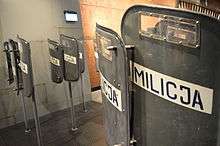Milicja Obywatelska


Milicja Obywatelska (Polish pronunciation: [miˈlit͡sja ɔbɨvaˈtɛlska]; Citizens' Militia or Civic Militia) was a state police institution in the People's Republic of Poland. It was created in 1944 by Soviet-sponsored Polish Committee of National Liberation, effectively replacing the pre-war police force. In 1990 it was transformed back into Policja.
The term milicja had been adapted from the cognate term, militsiya, used in several communist countries. The term is derived from militia, which in turn claims its etymology from the concept of a military force composed of ordinary citizens. Contrary to implied meaning, in most cases it represented rather a state-controlled force, used to exert political repression on the citizens.
Under both communist and post-communist governments, the Polish police system has traditionally operated under the auspices of national authority. Starting at the end of World War II, Poland,occupied by the Soviet Union, fell under the control of its eastern neighbor, especially in 1948 when the country's turn toward Stalinism brought the beginning of totalitarian rule.
Poland formed the Polish Citizen's Militia, a kind of police force, at the end of 1944, while Poland was still in a theater of war, but just before Europe became divided. The citizen's militia would remain the predominant means of policing in Poland until 1990. The highly centralized nature of the militia and its lack of any great power placed it largely under the control of the Security Bureau, which used it to instill fear in the local populace. The training offered at Legionowo was conducted in a barracks-style setting in buildings from the communist era. The training is conducted in the military style but without the U.S. practice of physical fitness in the morning, as Polish police officers are expected to maintain their physical fitness on their own. Some of the classes were on the cutting edge, such as their indoor firearms training.
Organisation

It was divided into a Public order and Traffic Militia (Highway Patrol), Criminal Investigations (major crimes, forensics), Investigations Milicja and an Infrastructure Security section (security of important buildings, installations, etc.).
There were regional, district, city and local detachments of the force.
The ZOMO motorized riot troops, which played the most visible role in quelling demonstrations in 1980 and 1981, were reduced in size somewhat by the early 1990s and renamed Preventive Units of the Citizens' Militia (Oddziały Prewencji Milicji Obywatelskiej—OPMO). OPMO forces are restricted to roles such as crowd control at sporting events, ensuring safety in natural disasters, and assisting the regular police. In theory, higher government authority would be required for large OPMO contingents to be used.[1]
From the 1960s through the 1980s, ORMO forces, which at one time numbered as many as 600,000 civilian volunteers, were used to augment regular police personnel at key trouble spots. In the early 1980s, ORMO harassed Solidarity members and prevented independent groups from organizing. Largely staffed by industrial workers who gained substantial privileges by monitoring their peers in the workplace, ORMO was the object of extreme resentment throughout the 1980s. Kiszczak attempted to promote ORMO as a valuable auxiliary police force, but the organization was abolished by the Sejm in 1990.[2]
Transportation
The most common types were:
- FSO Warszawa MO car
- Restored Polski Fiat 125p and Nysa 522 RSD Milicja Obywatelska vehicles
 FSO Polonez MR'78 militia car in Poznan 2011
FSO Polonez MR'78 militia car in Poznan 2011- Restored FSO Polonez MR'83 and Nysa 522 RSD of Citizens' Militia of Polish People's Republic (from the reenactment group milicja.waw.pl)

See also
- ORMO
- ZOMO
- Eastern Bloc politics
- Służba Bezpieczeństwa
- Ministry of Public Security (Poland)
- Militsiya
- Policja
- People's Militias (Czechoslovakia)
- Veřejná bezpečnost
References
- ↑ http://lcweb2.loc.gov/cgi-bin/query/r?frd/cstdy:@field%28DOCID+pl0277%29
- ↑ http://lcweb2.loc.gov/cgi-bin/query/r?frd/cstdy:@field%28DOCID+pl0277%29
| Wikimedia Commons has media related to Citizens' Militia in People's Republic of Poland. |
- History of the Milicja Obywatelska MO quoted by the police from Braniewo, originally by the Police School in Szczytno
- The history of the police in Poland from WWII to the present